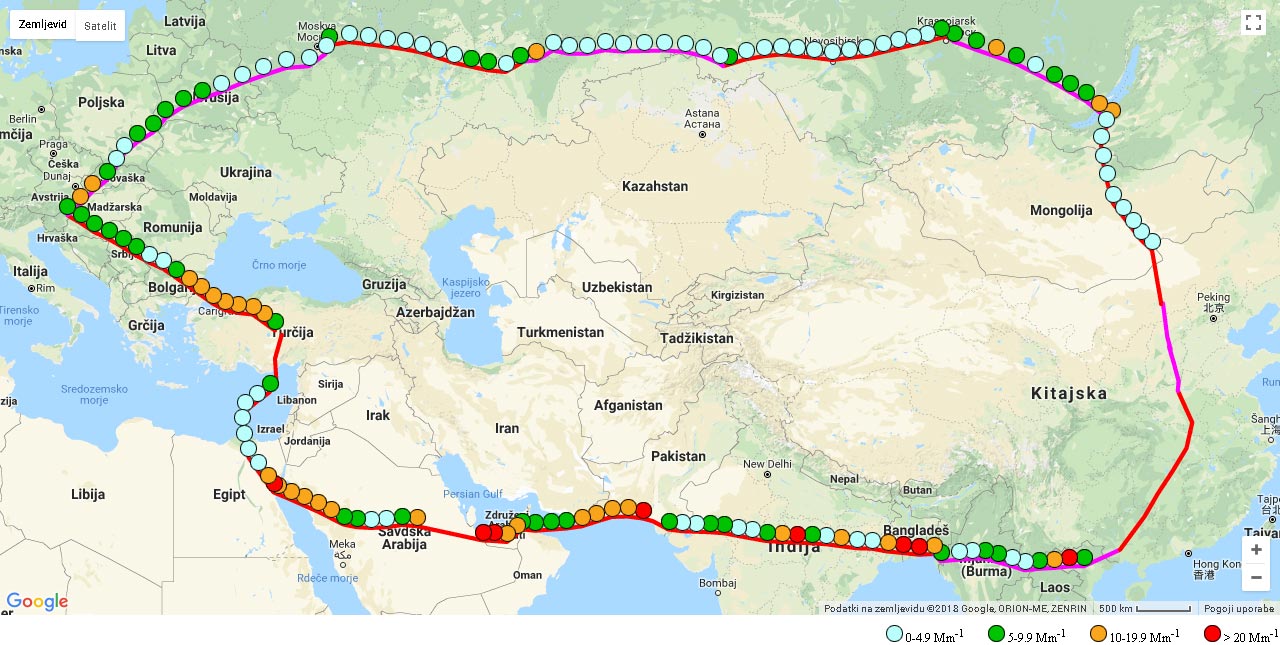Results of the GLWF 2018 mission
The results from measurement campaigns were presented in over 30 conference contributions globally. We will continue these activities in cooperation with scientists modeling regional and global emissions, their dispersion and their influence on the climate.

Aerosol absorption depends on their composition. Aerosol emitted by different sources contribute differently to climate change, also due to their different atmospheric life-time. The most important type of such aerosols is black carbon, after CO2 the second most important cause of global warming.
During the campaign GLWF 2018 we measured contributions from natural and anthropogenic sources. Desert dust, which is coarser, contributes significantly lower in the atmosphere. We have seen this especially over the Arabian Peninsula. It is noteworthy that also here very close to the ground anthropogenic combustion sources dominate. High in the atmosphere, products from fossil and biomass fuel combustion contribute most to the heating.
Concentrations of absorbing aerosols depend on the activity of the sources, dispersion in the atmosphere and the rate of deposition. Atmospheric mixing is very efficient over deserts and in the tropics due to large differences in temperature at night and during the day. Over Siberia, precipitation efficiently removed aerosols from the atmosphere despite forest fires over which the instrumented plane flew.
The influence of the emissions on the ground can reach high in the atmosphere and different sources influence the climate differently. This depends on the type of generated aerosols. This pollution is dispersed regionally depending on meteorological conditions, which are also responsible for the aerosol removal from the atmosphere. The influence of the sources may be regional, but usually local sources dominate.
The results from measurement campaigns were presented in over 30 conference contributions globally. We will continue these activities in cooperation with scientists modeling regional and global emissions, their dispersion and their influence on the climate.
Rezultati misije GLWF 2018
Absorpcija aerosolov je odvisna od njihove sestave. Aerosoli različnih virov zato različno prispevajo k podnebnim spremembam, kar je odvisno tudi od njihovega življenjskega časa v zraku. Najpomembnejši je črni ogljik, ki je za CO2 drugi najpomembnejši povzročitelj segrevanja atmosfere.
Med poletom GLWF 2018 smo izmerili prispevke naravnih in antropogenih virov. Puščavski pesek, ki je večji, močno prispeva k absorpciji nižje v atmosferi. To smo opazili predvsem nad Arabskim polotokom. Zanimivo je, da tudi tu čisto pri tleh dominirajo izpusti, ki jih ljudje povzročimo z zgorevanjem ogljičnih goriv. Visoko v atmosferi prispevajo k segrevanju produkti zgorevanja fosilnih goriv in biomase.
Koncentracije absorbirajočih aerosolov so odvisne od aktivnosti virov, disperzije v atmosferi in hitrosti odstranjevanja. Nad puščavami in v tropih je mešanje v atmosferi učinkovito zaradi razlik v temperaturah med nočjo in dnevom. Nad Sibirijo so padavine učinkovito odstranjevale aerosole iz zraka, kljub gozdnim požarom, nad katerimi je letelo letalo z inštrumenti.
Vpliv izpustov na tleh tako lahko seže visoko v atmosfero in različni viri vplivajo na podnebne spremembe drugače. To je odvisno od lastnosti aerosolov, ki nastanejo. Vremenski pojavi to onesnaženje širijo regionalno, povzročijo pa tudi odstranjevanje aerosolov iz atmosfere. Tako je vpliv virov sicer regionalen, največkrat pa so lokalni viri tisti, ki dominirajo.
Rezultate dosedanjih meritev smo predstavili na več kot 30 znanstvenih konferencah po celem svetu. S sodelovanjem z znanstveniki, ki modelirajo regionalne in globalne izpuste, njihovo širjenje in njihov vpliv na podnebje, bomo te aktivnosti tudi nadaljevali.







